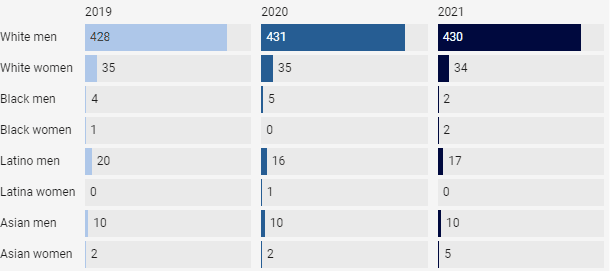Planning executive succession in an established business, or finding the first chairperson of a startup, both require careful consideration. It's a process that can take months, especially with today's seemingly limited executive talent pool.
If you're looking for a CEO, CFO, CIO, or other C-suite leader for your organization, then there are several challenges to overcome.
But don't worry, we've got solutions.
Let's review what executive recruitment looks like today and how you can incorporate recruiting tools in your hiring process to find an ideal candidate (or three) to fill your open executive position.
What is executive recruitment and why is it important to businesses?
Executive recruitment is the process of searching for individuals to fill senior-level management positions, such as chief executive officer, chief operations officer, or chief financial officer. Some use internal recruitment teams, while others hire executive search firms to find candidates.
Done right, executive recruitment can pair your organization with leaders that can propel your business forward. Who you hire to manage a department (or the entire organization) will determine its future success, so it's not a process to rush or take lightly.
Common challenges in executive recruitment
Finding executives to hire has never been an easy feat. And thanks to the pandemic, there are additional roadblocks to hurdle over.
Let's review the top issues HR professionals and talent acquisition specialists struggle with today.
Competition is fierce
The relatively small talent pool of executives, along with high demand, places the ball in the executives' court. This gives them the leg up to choose which companies they work with and at what salaries. If you can't compete with company culture, benefits, flexible hours, and salaries, then you'll struggle to win over candidates.
Get our tips for determining when to hire senior vs junior-level team members.
Skill gaps are widening
Baby boomers are exiting the workforce, and with them goes their executive management skills. Unfortunately, there aren't enough millennials available to replace them.
It's not a numbers game — it's about leadership skills, and many younger candidates aren't yet experienced enough to take on these executive positions. Unless you're proactively succession planning and offering mentorship to young successors, then this issue will continue.
Costs to recruit executives are astronomical
Finding executives that fit your company culture and budget is tough. Tie in the need to build relationships, run interviews, and onboard new hires and the time investment becomes costly.
It's one reason employers are turning to executive search firms to manage part of the process: talent sourcing.
Unfortunately, this route isn't that affordable.
In fact, a retained recruitment firm (the most commonly used for executive recruitment) can cost between 25% and 38% of the new hire's first-year salary. If the executive role pays $150K, the recruitment firm will ask for between $37,500 and $57K.
Then some charge a flat fee, which can reach into the mid-to-high $10Ks to the low $100Ks for larger firms.
Now that companies have access to resources like LinkedIn, it opens the door to doing executive recruitment in-house. However, even this can be a time-consuming process.
Most executives are passive candidates
When talent pools are lower, it's easier for candidates to get snagged by a company. This is why most top-talent candidates are currently employed. The good news: many are passively looking for better opportunities.
It's possible to find employed candidates who are unhappy in their current positions because of factors like:
- Low salary
- Poor work culture
- Work-life imbalance
- Misalignment in values
If you can show your company can offer the thing they're missing, then odds are you can get them to cross over. But you must take the first step in reaching out and building a relationship.
Executives aren't engaged (and are ghosting opportunities)
Ghosting isn't just an issue with smaller roles—it happens among executives as well. In fact, a Visier survey from earlier this year found that senior-level employees were actually more likely to ghost an employer than other levels of workers.
Why? Most likely, they're already employed and often in demanding roles in which they're overseeing a team or multiple teams. Executive candidates are also likely to be bombarded with multiple opportunities at once.
But the blame isn't 100% on the candidates. Companies that lack timely communication can lose prospective new hires to competitors with better offers, engagement, and overall enhanced candidate experiences.
Diversity remains a struggle on leadership teams
Diversity, equity, and inclusion efforts are big among employers large and small. But overcoming the challenge of employing a more diverse C-suite isn't always easy. This is especially true for larger Fortune 500 companies that are still run predominantly by white males.
Fortune 500 Company - CEO Demographics
 Source: SHRM
Source: SHRM
One roadblock preventing better diversity and inclusion is the way these organizations recruit. Many rely on their networks and relationships to hire new executives. Others recruit from specific colleges and universities with largely homogenous backgrounds.
Expanding your horizons to find a diverse talent pool is possible with nuanced searches that can unearth underrepresented candidates. With the right tools, TAs can connect with women and men of different races, sexualities, and abilities (or disabilities).
How tech can be used to find and engage executive talent
Technology is advancing the recruitment process, providing employers with the means to build a fluid candidate pipeline and a vast talent pool to tap into. However, many still rely on outdated (and expensive) executive search firms to recruit for them.
Internal recruitment teams can use talent-sourcing software to improve their executive search. Relying on LinkedIn and job boards isn't enough, because these platforms are already saturated with headhunters, and executives aren't always present on these platforms.
Recruiting software like Fetcher scans the web for candidates — a task that takes hours, and potentially days, to perform manually. Then using a tool with machine learning capabilities allows recruiters to better manage their communications to ensure candidates are consistently engaged and progress through the pipeline.
There's a reason corporate spending on AI software grew from $12.5B in 2017 to $46B in 2020. The report from Hunts Scanlon also reveals that 63% of respondents stated tech changed their organization's recruitment process. And 69% said it drove higher-quality candidates.
Respondents report that 59% of candidates are more qualified (than what they'd find five years ago), and 51% of employers can fill roles faster.
This technology isn't just a gimmick — it's a smart instrument that delivers data and insights to guide your recruitment process. It can reduce time spent sourcing candidates, automate communications to maintain engagement, and track candidate diversity to ensure you're striving toward DEI goals.
A real-world example showing the power of tech in executive recruiting
One common pet peeve about using an external recruiter or executive search firm is the lack of control you have over the recruitment process. It's difficult to direct an outsider on the intricacies of the type of person you're looking to fill the role.
It extends beyond employment backgrounds, degrees, and accolades, especially when you're searching for a CEO. This was the conundrum Network for Good faced in 2020.
Danica Remy, Vice Chair at Network for Good was responsible for finding a CEO, but she recognized that relying on a search firm would be expensive, and potentially limiting. Sourcing via LinkedIn would be tedious, and wouldn't provide the personalized outreach they wanted to catch the attention of high-level candidates. They needed a creative, strategic solution that would provide a diverse range of candidates, quickly.
After two months of sourcing with Fetcher, Network for Good had a solid pipeline of promising candidates and later made a final decision from among the Fetcher-sourced pipeline.

Learn more about Network for Good's CEO search.
About Fetcher
Our mission is to help you engage talent that will transform your business aspirations into reality. Great talent is hard to find - that's why we offer a talent sourcing platform that not only gets your brand in front of the right candidates but also gives you a competitive edge in talent acquisition.
Begin building a relationship with your next great hire today and let Fetcher handle the rest. Learn more.




